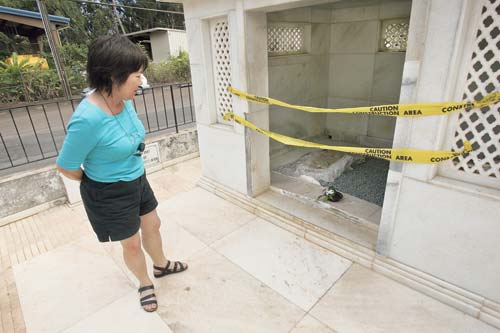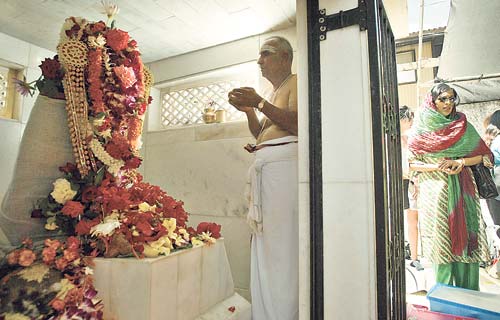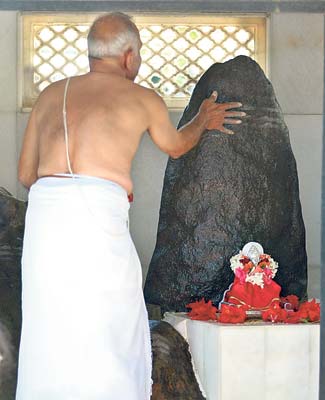Storied stone taken away

A healing stone in Wahiawa sacred to both Hindus and Hawaiians has gone missing. The concrete structure housing it along California Avenue stood empty yesterday as Honolulu resident Pam Seeney looked in.

S. Ramanathan pays his respects to the healing stone in Wahiawa during a ceremony as a woman who wished to be unidentified waits for her turn. Ramanathan was one of the priests who conducted the ceremony, which consisted of cleansing the stone and presenting offerings in the form of food and flowers.»

S. Ramanathan rubs a piece of the sacred stone with ash after a ritual cleansing in 2005, during which the stone was bathed in milk, rubbed with honey and draped with lei. Hindus revere the stone as a manifestation of the god Shiva.



The so-called healing stone of Wahiawa, venerated for more than 20 years by a local Hindu group as an embodiment of the god Shiva, was removed from its display platform on California Avenue last week by a group of Hawaiian nationalists intent of returning it to its earlier resting place near the Kukaniloko birthing site.
Both the Hindu and Hawaiian groups had shared in the care of the storied stone in recent years.
Dipankar Sengupta, one of the founders of the Lord of the Universe Society, the nonprofit Hindu group that assumed caretaker duties for the stone in 1988, said a group of people showed up early June 11 and used jackhammers to remove the stone (which had previously split into three pieces) from the cement where it was anchored.
"We believe that God can be everywhere and that a stone can represent God," Sengupta said. "For 21 years we put much love and care into taking care of the stone. It seems unfair that one group would unilaterally take it away. Emotionally, people are very upset."
But Tom Lenchanko, kahu of Kukaniloko, which served for centuries as a birthing spot and educational center for alii, said that those involved in moving the stone were simply adhering to the instructions of their ancestors.
"There is no other issue but that," he said. "It is our duty to malama the things that are sacred and put them where they belong. Our kupuna told us it was time to take them home, and we did. And if we take care our kupuna, our kupuna take care us."
Don't miss out on what's happening!
Stay in touch with breaking news, as it happens, conveniently in your email inbox. It's FREE!
Lenchanko said he contacted the owner of the property on which the structure sat and got his permission to move the stone.
He said the three pieces of stone are being kept at a private location "to rest."
"There is no next step," he said. "If our kupuna tell us to do something else, we will. But right now the stone needs to rest and gather its energy in private."
A group of Japanese tourists arrived at the site late yesterday afternoon only to be disappointed that the stone was no longer there. They covered their mouths in disbelief and laughed nervously as they removed their shoes to walk along the white marble flooring of the raised platform. The marble-lined structure that housed the rocks is still intact, save for a few significant chips, but the spot where the stone was lay empty but for a few pieces of broken concrete and a trio of plucked yellow hibiscus. A small plastic bowl of flowers was left at the entrance. In the back were a dried lei, a picture of Shiva, a candle and a few sticks of incense.
Yuzo Tanaka, a tour guide for Dolphins and You, said he takes tour groups to the site once or twice a month as the first stop of a tour that also includes Kukaniloko.
"Unbelievable," Tanaka said. "Why would someone take the stone?"
Kahu Elithe Kahn, one of the group of Hawaiians who helped to watch over the stone, said she understood why people were upset, but likened the removal to "pulling a tooth for the betterment of the entire body."
"We truly appreciate the care that (LOTUS) provided over the years, but this is a Hawaiian icon, not Hindu," Kahn said. "Hopefully, they will be able to bring over one of their own gods or goddesses to shelter and worship to the full scope of their belief."
According to Lenchanko, the stone — called Keanianileihuaokalani — was originally located in a stream bed in Kaukonahua gulch and served as a kapu marker for those passing from Waialua.
The stream was part of lands that would eventually be controlled by Waialua Sugar Co. At some point, plantation official George Galbraith allowed the stone to be moved to Kukaniloko after someone (reportedly either a Hawaiian man or a Japanese field worker) claimed that it had healing powers.
In 1927 the Daughters of Hawaii, which assumed responsibility for the Kukaniloko site, had the stone moved to the edge of a cemetery at what is now the California Avenue site, where it drew hundreds of visitors in the 1920s and 1930s, many of whom burned incense, left offerings of food or money and rubbed wax and oil on its surface.
"The stone was never a healing stone," Lenchanko said, "and what people did to it, although it wasn’t their intention, was disrespectful."
LOTUS assumed care of the dilapidated site in 1988, constructing the marble shrine with a donation from the Sawney family. Kahn and other Hawaiian women joined in the care of the stone about five years ago.
Kahn said removal of the stone was timed to coincide with favorable conditions indicated by traditional Hawaiian lunar astrology. She said its return to Kukaniloko will mark the fulfillment of an obligation to kupuna and the rise of a restored kanaka maoli nation.




